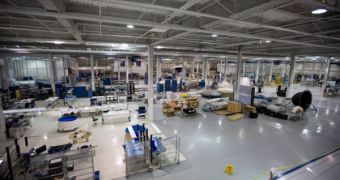In these financially troubled times, creating an enterprise that works is a real challenge, but Space Exploration Technologies Corporation, a start-up in the rocket industry, seems to be doing just fine in that regard. Founded in 2002, the company already has plans to launch the newest in a series of rockets this year.
The two liftoff procedures are scheduled to take place no later than this winter, and, if all goes according to plan, the Falcon 9 will dock to the International Space Station by 2010. After that, chances are that it will be turned into the NASA-operated Commercial Orbital Transportation Services, which will replace the shuttles until Project Constellation is online.
The difference between the Hawthrone, California-based start-up and the American space agency in terms of work spaces and conditions is obvious from the beginning. In a space looking more like the Googleplex, SpaceX rocket scientists work on an open-floor structure, with common workbenches, and conference rooms with glass walls.
In other similar enterprises, everything is done behind closed doors, and in private offices and conference spaces. Hundreds of engineers and “brainiacs” are employed at the rocket factory, which is located inside a former 747 fuselage-assembly plant. And SpaceX's main man, PayPal founder Elon Musk, has said that the company is based on a few very basic principles, including innovation, in-house manufacturing and minimal bureaucracy. He believes that too many signed papers hinder innovation, as well as the ability an enterprise has to move fast, and accomplish its goals quickly.
SpaceX is a good example of a “child prodigy” in the industry. Founded only seven years ago, it delivered its first cargo to orbit in September 2008, aboard a Falcon 1 delivery system. Now, everyone in the rocket community is waiting to see how its precursor will fare.
The main goal of the rocket company is not necessarily to send innovative types of rockets to orbit, or to revolutionize space flight altogether, but more in the lines of sending a payload into orbit at one tenth of the price that state space agencies around the world now charge satellite companies or governments. If they manage to do that, they could reduce the price of an average launch from $100 million to $10 million, or maybe even less.
This could generate a boom in the industry, as many companies will have access to orbital capabilities. Additionally, all other space agencies, which have thus far adopted innovation at a slow pace, will have to put on extra effort to keep up with the private sector, Wired reports.

 14 DAY TRIAL //
14 DAY TRIAL // 

